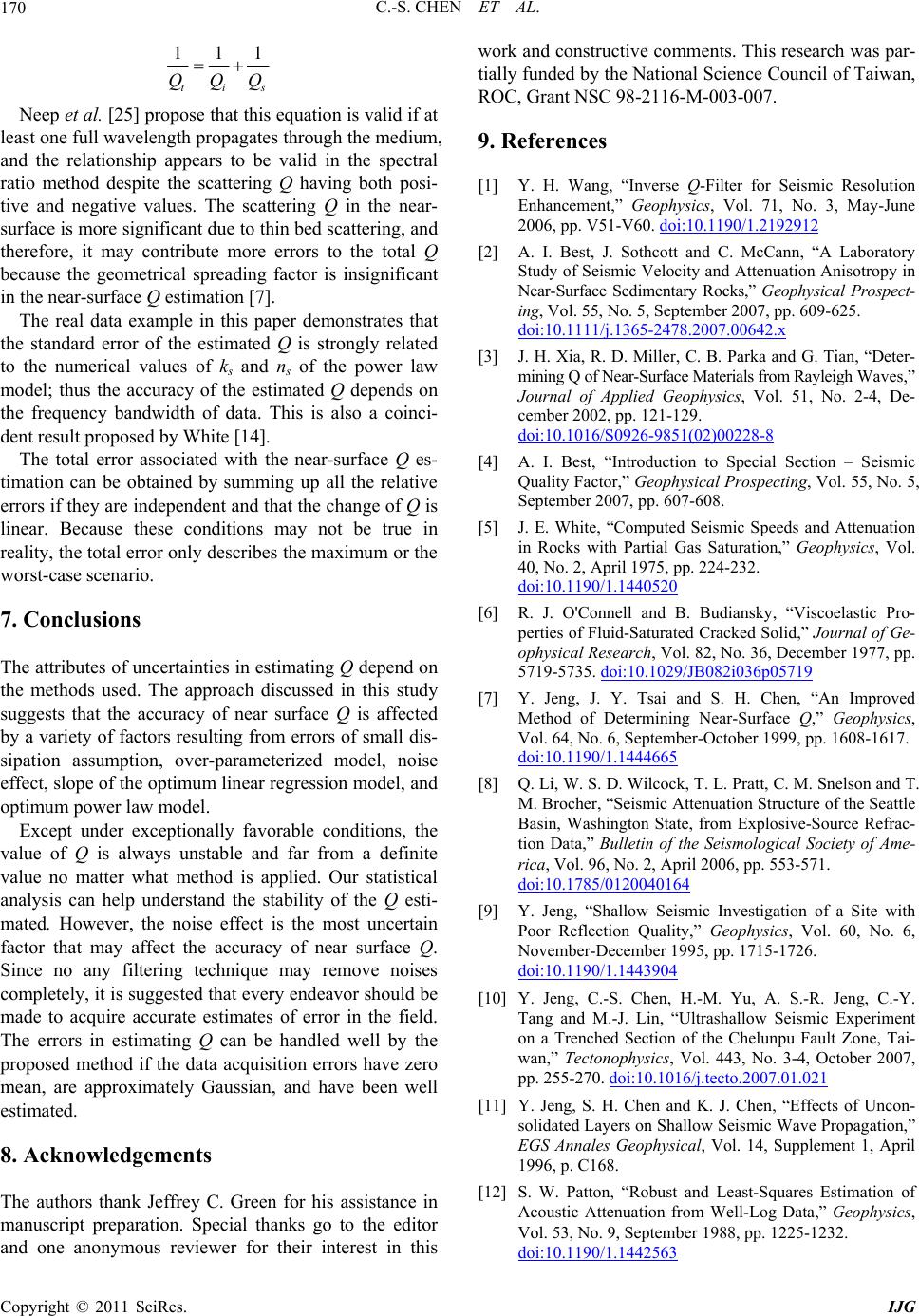
C.-S. CHEN ET AL.
170
111
tis
QQQ
Neep et al. [25] propose that this equation is valid if at
least one full wavelength propagates through the medium,
and the relationship appears to be valid in the spectral
ratio method despite the scattering Q having both posi-
tive and negative values. The scattering Q in the near-
surface is more significant due to thin bed scattering, and
therefore, it may contribute more errors to the total Q
because the geometrical spreading factor is insignificant
in the near-surface Q estimation [7].
The real data example in this paper demonstrates that
the standard error of the estimated Q is strongly related
to the numerical values of ks and ns of the power law
model; thus the accuracy of the estimated Q depends on
the frequency bandwidth of data. This is also a coinci-
dent result proposed by White [14].
The total error associated with the near-surface Q es-
timation can be obtained by summing up all the relative
errors if they are independent and that the change of Q is
linear. Because these conditions may not be true in
reality, the total error only describes the maximum or the
worst-case scenario.
7. Conclusions
The attributes of uncertainties in estimating Q depend on
the methods used. The approach discussed in this study
suggests that the accuracy of near surface Q is affected
by a variety of factors resulting from errors of small dis-
sipation assumption, over-parameterized model, noise
effect, slope of the optimum linear regression model, and
optimum power law model.
Except under exceptionally favorable conditions, the
value of Q is always unstable and far from a definite
value no matter what method is applied. Our statistical
analysis can help understand the stability of the Q esti-
mated. However, the noise effect is the most uncertain
factor that may affect the accuracy of near surface Q.
Since no any filtering technique may remove noises
completely, it is suggested that every endeavor should be
made to acquire accurate estimates of error in the field.
The errors in estimating Q can be handled well by the
proposed method if the data acquisition errors have zero
mean, are approximately Gaussian, and have been well
estimated.
8. Acknowledgements
The authors thank Jeffrey C. Green for his assistance in
manuscript preparation. Special thanks go to the editor
and one anonymous reviewer for their interest in this
work and constructive comments. This research was par-
tially funded by the National Science Council of Taiwan,
ROC, Grant NSC 98-2116-M-003-007.
9. References
[1] Y. H. Wang, “Inverse Q-Filter for Seismic Resolution
Enhancement,” Geophysics, Vol. 71, No. 3, May-June
2006, pp. V51-V60. doi:10.1190/1.2192912
[2] A. I. Best, J. Sothcott and C. McCann, “A Laboratory
Study of Seismic Velocity and Attenuation Anisotropy in
Near-Surface Sedimentary Rocks,” Geophysical Prospect-
ing, Vol. 55, No. 5, September 2007, pp. 609-625.
doi:10.1111/j.1365-2478.2007.00642.x
[3] J. H. Xia, R. D. Miller, C. B. Parka and G. Tian, “Deter-
mining Q of Near-Surface Materials from Rayleigh Waves,”
Journal of Applied Geophysics, Vol. 51, No. 2-4, De-
cember 2002, pp. 121-129.
doi:10.1016/S0926-9851(02)00228-8
[4] A. I. Best, “Introduction to Special Section – Seismic
Quality Factor,” Geophysical Prospecting, Vol. 55, No. 5,
September 2007, pp. 607-608.
[5] J. E. White, “Computed Seismic Speeds and Attenuation
in Rocks with Partial Gas Saturation,” Geophysics, Vol.
40, No. 2, April 1975, pp. 224-232.
doi:10.1190/1.1440520
[6] R. J. O'Connell and B. Budiansky, “Viscoelastic Pro-
perties of Fluid-Saturated Cracked Solid,” Journal of Ge-
ophysical Research, Vol. 82, No. 36, December 1977, pp.
5719-5735. doi:10.1029/JB082i036p05719
[7] Y. Jeng, J. Y. Tsai and S. H. Chen, “An Improved
Method of Determining Near-Surface Q,” Geophysics,
Vol. 64, No. 6, September-October 1999, pp. 1608-1617.
doi:10.1190/1.1444665
[8] Q. Li, W. S. D. Wilcock, T. L. Pratt, C. M. Snelson and T.
M. Brocher, “Seismic Attenuation Structure of the Seattle
Basin, Washington State, from Explosive-Source Refrac-
tion Data,” Bulletin of the Seismological Society of Ame-
rica, Vol. 96, No. 2, April 2006, pp. 553-571.
doi:10.1785/0120040164
[9] Y. Jeng, “Shallow Seismic Investigation of a Site with
Poor Reflection Quality,” Geophysics, Vol. 60, No. 6,
November-December 1995, pp. 1715-1726.
doi:10.1190/1.1443904
[10] Y. Jeng, C.-S. Chen, H.-M. Yu, A. S.-R. Jeng, C.-Y.
Tang and M.-J. Lin, “Ultrashallow Seismic Experiment
on a Trenched Section of the Chelunpu Fault Zone, Tai-
wan,” Tectonophysics, Vol. 443, No. 3-4, October 2007,
pp. 255-270. doi:10.1016/j.tecto.2007.01.021
[11] Y. Jeng, S. H. Chen and K. J. Chen, “Effects of Uncon-
solidated Layers on Shallow Seismic Wave Propagation,”
EGS Annales Geophysical, Vol. 14, Supplement 1, April
1996, p. C168.
[12] S. W. Patton, “Robust and Least-Squares Estimation of
Acoustic Attenuation from Well-Log Data,” Geophysics,
Vol. 53, No. 9, September 1988, pp. 1225-1232.
doi:10.1190/1.1442563
Copyright © 2011 SciRes. IJG